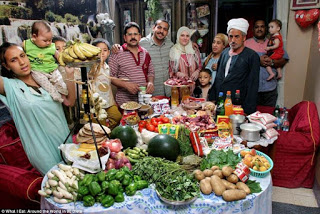I’m excited to share with you an article from The Daily Mail UK which very poignantly shows the difference in how different families eat (and what they spend on food) around the world. Journalists visited 30 countries and asked regular families to take photos of what they would bring home from the grocery store to eat in a typical week.
One of the top scores for a balanced diet, in my books, goes to the Egyptian family pictured above. Note the proportion of veggies relative to meat! Leaner cuts of meat (or fish) would be preferred, and I’d switch up the pop for water (or diet pop at least), but overall they are doing pretty well. I must say that when I travelled Egypt years ago with my best friend Deb, I remember enjoying lots of healthy (and very tasty) meals – it’s amazing what Bedouins can whip up in the middle of the desert under a starlit sky.
Now let’s visit a family in Bhutan (above). Again, lots of veggies, but definitely lacking in protein sources, likely due to lack of accessibility. (Thankfully, the WHO Bhutan program has been working on improving nutritional issues in this country including anemia and protein energy malnutrition.)
Family Japan (above) is doing a great job, with excellent protein sources (lots of fish), though they could go a little heavier on the vegetables. Japan has one of the lowest obesity rates in the world. There are many things we can learn from how the Japanese prepare their food as well, and how this thoughtful preparation can result in lower calorie intake – see my thoughts re the bento box here.
Now let’s contrast family USA (above) with family Egypt (at the top). Note the dramatic difference in prepackaged foods, sore lack of vegetables in the US family’s weekly shop, and the carbs, fat, and fast food that dominate the American diet. Notice also how much food the US family of 4 consumes in a week, compared to the food consumed by Egyptian family of 12! USA has one of the highest obesity rates on the planet.
And how did family Canada do? Interestingly, the journalists chose a family from Nunavut, represented above. I’m pleased to see not too much packaged food, some great fish protein, but again, vegetables fill far less of the table than many other countries’ families studied.
Clearly, these families are just one from each country, and what different families consume in each country will vary greatly. What families around the world are able to purchase also depends heavily on both physical accessibility, as well as the cost of food. Note from the article that the cost of family Egypt’s food was 43 GBP (about $66 USD) for the week, whereas the green peppers and tomatoes on that table alone would cost at least that much in Canada. (This cost has to be balanced against the typical income in each country as well, so…. it’s complicated!) However, it is very interesting and educational to have a flip through all of the countries studied in the article itself, and to ponder how the typical food choices of each family relate to the prevalence of obesity in each of their countries.
Enjoy!
Dr Sue Pedersen www.drsue.ca © 2013
Follow me on Twitter for daily tips! @drsuepedersen
















